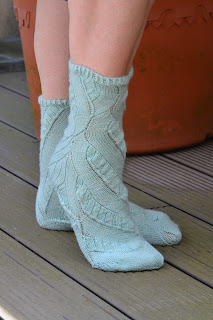Hij gebruikt in zijn werk veel zwart-wit rechte en gebogen lijnen, die naast elkaar geplaatst worden en zo beweging oproepen. Dit principe wordt ook gebruikt in het zogenaamde 'schaduwbreien', waar ribbelsteek in één kleur afwisselt met tricotsteek in een andere kleur. In het boek zijn de sokken uitgewerkt in felgroen en hardroze.
This is the last pattern from the Op-Art book, named after Heinz Mack.
Op-art artists, such as Heinz Mack (born 1931), evoke the impression of lines and curves by the juxtaposition of alternating black and white lines. This concept is also used in shadow knitting in which garter ridges in one color alternate with single rows of stockinette stitch in a contrasting color. In the book these socks are knit in shocking pink and vivid green.
En dit is mijn versie in zachtere tinten. De kleuren worden per blokje afgewisseld, dus eerst zandbeige voor de ribbelsteek en wit voor de tricotsteek, en dan weer omgekeerd. Dit zou voor visuele beweging moeten zorgen. Ik gebruikte restjes en natuurlijk had ik niet genoeg, dus uiteindelijk heb ik nog wat zachtgeel voor de tenen en de boord gebruikt.
This is my version of these socks, in sand and white. I ran out of yarn (using leftoves), so finished of with a soft yellow. For this sock design, the color of the garter ridges alternates between adjacent blocks (or crescents) of pattern to produce visual movement.
En dat was het dan. Alle 19 patronen uit het boek zijn gebreid. Ik heb er veel bij geleerd, en ik heb er toch een aantal mooie en draagbare sokken aan overgehouden. En ik heb nog wat opgestoken over Op-Art.
The op-art shapes are worked one on top of another in brick fashion in rows, then joined to form tubes. The leg is grafted together, and then the foot and toes are knit in 'normal' sock-knitting mode.
I did not enjoy these at all. It's very hard to get a neat seam diagonally. And now I have knit all 19 patterns from the book. I learned a lot, and I have some nice and wearable socks. Not all were a succes, but it was nice to have a focus on creative sock-knitting. And I learned a bit about Op-Art too!
Dit is mijn top drie uit het boek:
Looking back, these are my top three from the book:
Fibonacci, de lievelingssokken van de dochter, en de eerste kleurinbreisokken die echt goed aanpassen
Fibonacci, welloved by my daughter, and the first colorwork socks I have knit that really fit well.
Crest - sokken met kabeltjes. Ik dacht, 'dat ken ik', maar ik ben erin geslaagd om zowat alles fout te doen. Helemaal opnieuw begonnen, en toch nog gelukt tegen de deadline, dat gaf veel voldoening. En het zijn heel mooie sokken geworden.
Crest - socks with travelling stitches and cables. I really struggled with these, so finishing them against the deadline gave me a big sense of accomplishment.
Ludwig - de lievelingssokken van de zoon. Voor hem heb ik ze wat korter gemaakt dan in het boek, zo heeft hij zijn sokken graag. Dat vroeg wat nadenken, en was niet van de eerste keer juist, maar uiteindelijk toch weer een mooi eindresultaat.
Ludwig - my son's favorites. I made them a bit shorter then in the book, as my son likes short socks. And of course I did not manage to do it properly, and had to restart, but all ended well in the end.
Voor 2016 staat mijn besluit vast: er komen nog wel sokken, maar alleen supersimpele! De ingewikkelde technieken houd ik voor andere projecten...
I am sure I will continue knitting socks in 2016, but my resolution is only to knit supersimple ones...




















































